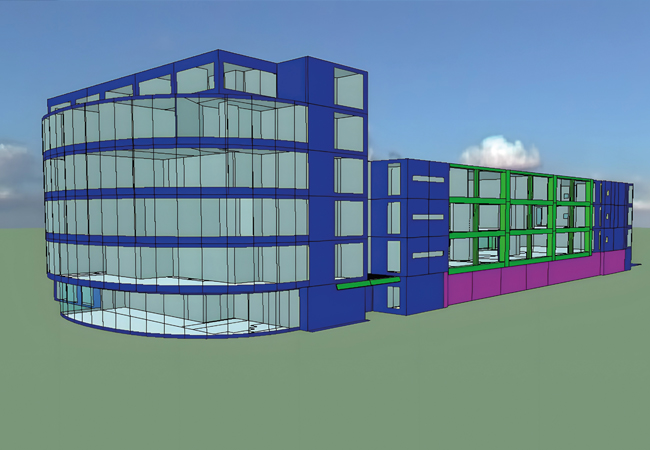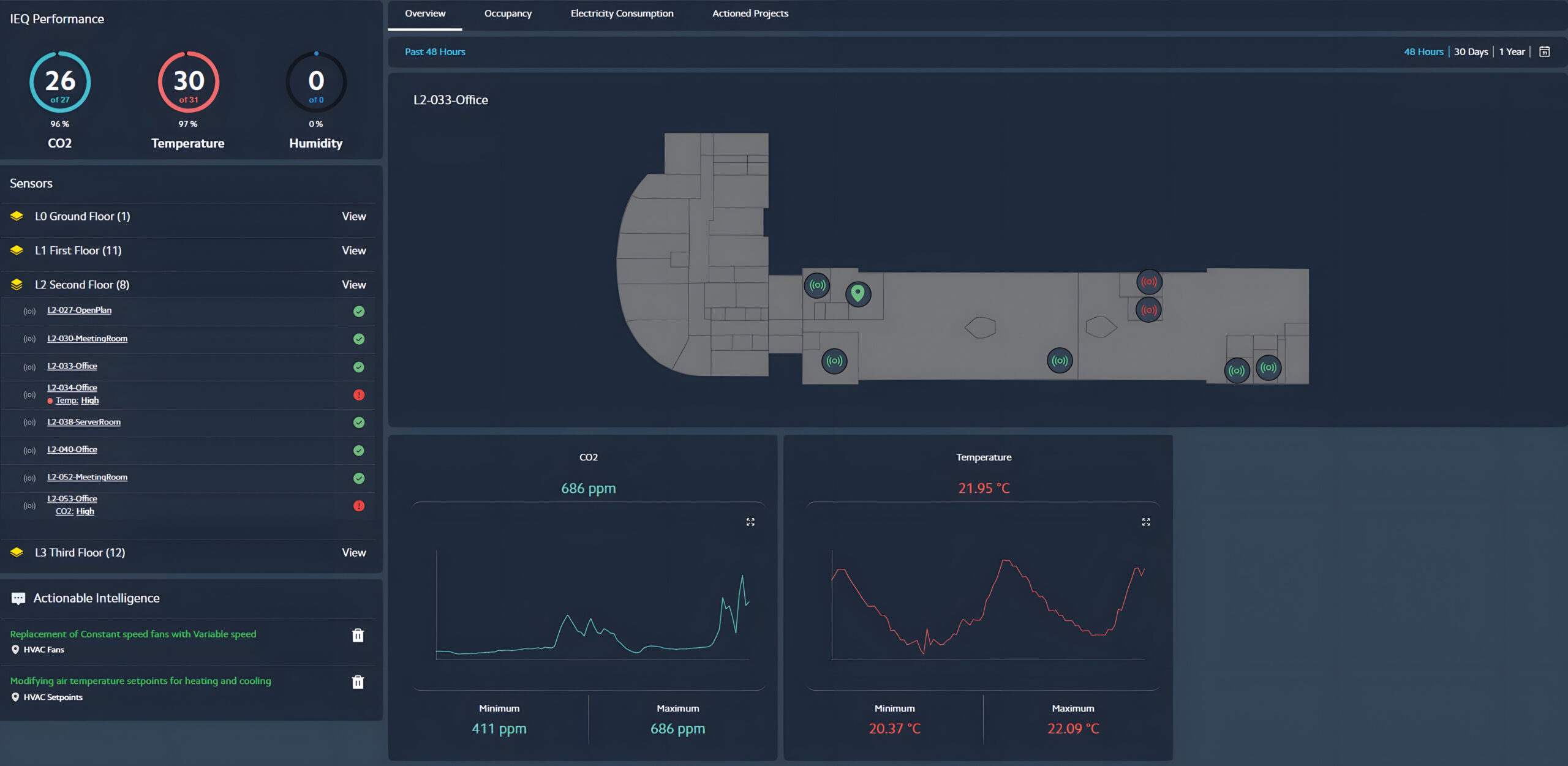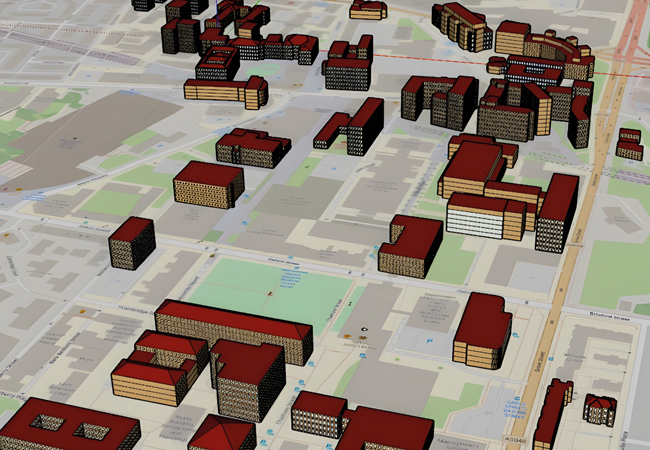
Model of the Foundation Building and the University of Liverpool
Many building owners overlook the fact that their design model – often seen as just a compliance tool – can be a valuable asset capable of saving thousands in energy costs. Once the model has fulfilled its role in demonstrating compliance with Building Regulations and securing planning permission, it is rarely revisited.
Software developers are striving to change this by using the model as a basis for a digital twin that can simulate the impact of energy-saving interventions using live operational data.
‘Building owners use the model to gain certification or comply with Building Regulations, then forget about it. The model helps tick the compliance box and that’s it,’ says Valeria Ferrando, associate director at IES.
‘We want to maximise the energy model that they have already invested in. You can get more value and unlock savings without adding a lot of cost,’ she says.
Last year, IES created a digital twin for the University of Liverpool that used its IES Live tool to link an energy model of the university’s Foundation Building with data from the building management system (BMS) and sensors. The software enables the facilities management (FM) team to track operational performance and gain insights for energy, carbon and comfort. In this instance, they were able to see the impact on energy use of the university replacing an existing air handling unit (AHU) with two new units and implementing a demand-control ventilation strategy.
In phase one of the refurbishment project, IES Virtual Environment was used to create an initial energy model, which was calibrated against monthly measured data for 2019 (pre-pandemic) to create a performance digital twin. This allowed the prediction of the baseline energy use of the building and testing of refurbishment options – the digital twin predicted 14% estimated energy savings from the AHU improvement.
Once phase one was complete and the building reopened, the digital twin was recalibrated to match measured data from the BMS and energy meters on an hourly basis.

Figure 1: Dashboard showing sensor out of temperature range, at 24.1°C
On a single-pane view (similar to that shown in Figure 1), IES Live displays the carbon and cost savings of building improvements compared with a baseline model featuring no interventions. It shows a 20.95% cut in energy consumption and savings of £50,080 in the period from February 2023 to May 2025. Ferrando says the larger savings were because the building was modelled before the Covid pandemic, when occupancy was higher.
If there is no energy model in existence, one can be created from scratch by IES, adds Ferrando. Monitoring systems – including wireless sensors and current transformer clamps – can also be installed to capture relevant data.
The model is the organisation’s own asset, but it will be in the cloud, to allow integration with tools such as IES Live, says Ferrando. The cloud also ensures there is enough processing power to run advanced analytics and simulations on real-time data: the cloud can dynamically scale this capacity based on demand, which local servers typically cannot do efficiently.
The university’s FM team is also now using this operational performance digital twin, accessed via IES Live, to continually monitor and improve the building, and to look at further potential interventions.
Alerts can be set up if readings are not within a set range (for CO2, for example). On the dashboard, a red dot will indicate if, say, the temperature measured by a sensor is not within the set range (see Figure 1).
The university is creating digital twins for another part of the Foundation Building – the Wing – as well as three other facilities: the Central Teaching Hub, the Materials Innovation Factory (MIF) and the Yoko Ono Lennon Centre.
Energy audits have been carried out, with suggested interventions, and digital twins will be used to model interventions. The university is using IES Live to assess the effectiveness of interventions already taken and to predict the impact of potential changes. At MIF, the software shows that a photovoltaic (PV) installation has cut energy use by 1.09% and saved £20,850 for the two years up to 13 May 2025.
Ferrando says simulations can be carried out for potential interventions that do not cost anything, such as changing temperature setpoints for heating and cooling. ‘This is very powerful, because it can show that, without any investment, you can save money, and operate the building more efficiently,’ she says.
Governance of the digital twin is important, because stakeholders may have different objectives, says Ferrando. For example, it may make sense to turn off heating on one floor of the library on a quiet day, but students may be upset if it restricts them from their preferred study areas. There may also be a compromise between comfort and energy savings, if temperature ranges are allowed to rise to reduce cooling loads, for example. ‘It’s not always straightforward to make changes. It’s important to know who is deciding what,’ says Ferrando.
The digital twin initiative is being overseen by Tony Small, the University of Liverpool’s head of engineering services.
One of the biggest challenges is creating a connection for the data, particularly for sites with a complex BMS. ‘It’s important to get support from someone within the client who can obtain the data from a third-party supplier. We are working on solutions that standardise the data connection for specific protocols – for example, BACnet,’ says Ferrando.

Figure 2: The energy centre model includes simple geometry of buildings connected on the heat network
Twin interests
There is growing interest in digital twins from large energy users, such as data centres.
Ferrando says IES has built a demo based on a model created for a client’s data centre, with the idea of taking the model beyond the design phase. Metrics clients are focused on include power usage effectiveness and space cooling.
Twins can be used for decarbonisation strategies for a portfolio of buildings. A high-level system-modelling tool allows users to create abstract representations of building services. With less model detail, simulations can be run across many properties.
An exciting development is the scenario modelling being done at the university’s district heating system. IES has simulated six energy-conservation measures and potential energy saving, including fabric upgrades, distribution loss improvements and boiler replacements.
The savings – which range from 3.3% from thermal storage to 43.1% for boiler replacement without combined heat and power – represent significant opportunities for the university.
